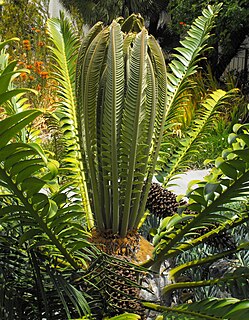
Encephalartos transvenosus is a palm-like cycad in the family Zamiaceae, with a localized distribution in Limpopo, South Africa. Its common names, Modjadji's cycad or Modjadji's palm, allude to the female dynasty of the Lobedu people, the Rain Queens, whose hereditary name is Modjadji. The queen resides near a valley which is densely forested with these cycads, which they protected and hold sacred. The species name transvenosus refers to the fine network of veins between the main veins. These can be seen when the leaf is held up to the light.

Encephalartos is a genus of cycad native to Africa. Several species of Encephalartos are commonly referred to as bread trees, bread palms or kaffir bread, since a bread-like starchy food can be prepared from the centre of the stem. The genus name is derived from the Greek words en (within), kephalē (head), and artos (bread), referring to the use of the pith to make food. They are, in evolutionary terms, some of the most primitive living gymnosperms.
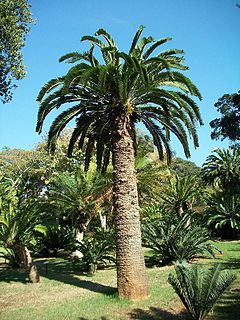
Encephalartos woodii, Wood's cycad, is a rare cycad in the genus Encephalartos, and is endemic to the oNgoye Forest of KwaZulu-Natal, South Africa. It is one of the rarest plants in the world, being extinct in the wild with all specimens being clones of the type. The specific and common name both honour John Medley Wood, curator of the Durban Botanic Garden and director of the Natal Government Herbarium of South Africa, who discovered the plant in 1895.

Lepidozamia peroffskyana is a palm-like cycad in the family Zamiaceae. It is endemic to eastern Australia. The species is named after Count Peroffsky (1794-1857), benefactor of the St. Petersburg Botanical Garden.

Encephalartos horridus, the Eastern Cape blue cycad, is a small, low-growing cycad up to 0.9 m (3.0 ft) high and 0.9 m (3.0 ft) wide. It is a native of Eastern Cape Province, South Africa, and found in arid shrublands, most commonly on ridges and slopes with shallow soils. The species is particularly known for its distinctly blue-gray leaves, although the degree of coloration can vary significantly. The species name horridus is Latin for 'bristly', after the plant's stiff, spiny leaflets.
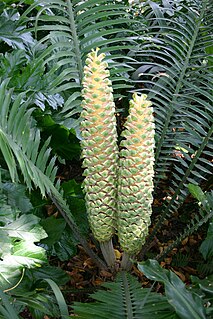
Encephalartos villosus is a South African cycad occurring from the East London vicinity, where it is found near the coast, to the northern border of Eswatini (Swaziland) where it may grow as far as 100 km inland. The species is common throughout its range and is the most frequently cultivated in Southern Africa, largely because of its affordable price. As a result of its large geographical distribution, it is notably variable in leaf and cone shape.

Areas of forest which grow in KwaZulu-Natal, South Africa mostly on south facing slopes in higher rainfall areas, and along the humid coastal areas. Different types of forest can be identified by their species composition which depends mostly on the altitude, latitude and substrate in which they grow. South facing slopes are favourable for the development of forest as they are more shaded, and therefore cooler and retain more moisture than the northern slopes. The extra moisture on the south slopes is not only favoured by forest trees, but also helps to prevent or subdue wildfires. Fires can also be blocked by cliff faces and rocks or boulders on these slopes, and by streams or rivers at the base of the slopes. The coastal regions are conducive to forest formation, because of high rainfall and humidity which are favoured by forest trees and also help to prevent or subdue fires. The rivers of the coastal areas are also broader than further inland, which may often prevent fires from spreading long distances, and fires generally burn uphill and therefore more often away from areas at low altitude.
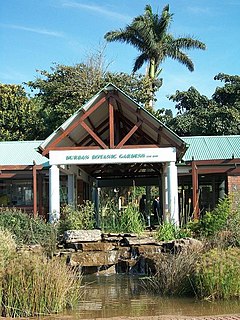
The Durban Botanic Gardens is situated in the city of Durban, KwaZulu-Natal, South Africa. It is Durban's oldest public institution and Africa's oldest surviving botanical gardens. The gardens cover an area of 15 hectares in a subtropical climate.

Encephalartos altensteinii is a palm-like cycad in the family Zamiaceae. It is endemic to South Africa. The species name altensteinii commemorates Altenstein, a 19th-century German chancellor and patron of science. It is commonly known as the breadtree, broodboom, Eastern Cape giant cycad or uJobane (Zulu). It is listed as vulnerable due to habitat destruction, use for traditional medicine and removal by collectors.

Encephalartos lehmannii is a low-growing palm-like cycad in the family Zamiaceae. It is commonly known as the Karoo cycad and is endemic to South Africa. The species name lehmannii commemorates Prof J.G.C. Lehmann, a German botanist who studied the cycads and published a book on them in 1834. This cycad is listed as near threatened in the IUCN Red List of Threatened Species.
Encephalartos brevifoliolatus, the escarpment cycad, is a cycad in the African genus Encephalartos. It is extinct in the wild. The escarpment cycad is an African plant that was found in South Africa's short grasslands in the very open Protea savanna. These plants are used to growing on large cliffs.
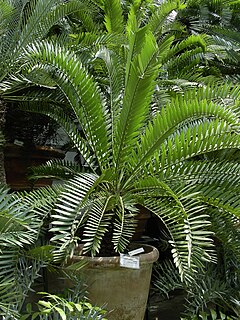
Encephalartos caffer, the Eastern Cape dwarf cycad, is a rare cycad from the genus Encephalartos. It typically has an underground stem, with a small portion on top, the stem is only very rarely branched and may be as much as 40 cm long. Emerging from the top are long, pinnate, dark green leaves up to 1 metre (3.3 ft) long. These often have a distinctive ruffled, feathery appearance, caused by the numerous, clustered leaflets being irregularly twisted from the central stalk and pointing out in different directions. New leaves are brown and woolly at first but most of the hair is lost as they mature, although they never become completely smooth or glossy. Both male and female plants bear single reproductive cones made up of a series of spiraled scales, which become greenish-yellow when mature. In the female, two largish, glossy, scarlet-coloured seeds are formed on top of each cone scale.

Encephalartos ghellinckii Lem. or Drakensberg cycad is endemic to South Africa, and is one of about 70 species found in sub-Saharan Africa. Strongly associated with the Natal Drakensberg, this 3m tall evergreen species is found from the foothills to fairly high altitudes, growing on stream banks, steep grassy slopes and sandstone outcrops. Its preferred habitat lying within grassveld, it has developed resistance to veldfires, and also the intense cold brought on by snow and frost.

Encephalartos lebomboensis is a species of cycad in the family Zamiaceae. Native to the Lebombo Mountains of South Africa, the species was first described in 1949 by the South African botanist Inez Verdoorn. It is commonly known as the Lebombo cycad, although the name is also used for Encephalartos senticosus which also occurs in the same locality.

Encephalartos natalensis, the Natal cycad or giant cycad, is a species of cycad that is endemic to the Qumbu and Tabankulu areas of the northern part of the Eastern Cape, and through most of KwaZulu-Natal. The number of mature individuals of this species is declining and the International Union for Conservation of Nature has assessed its conservation status as being "near threatened".

Encephalartos hirsutus is a species of cycad that is native to Limpopo Province, South Africa. It was recorded from three separate localities on south-east-facing quartzite cliffs in the Makuya Nature Reserve bordering the Kruger National Park at altitudes ranging from 800 to 1,000 meters above sea level.

Encephalartos lanatus is a species of cycad, a plant belonging to the family Zamiaceae growing in Mpumalanga, South Africa. Its specific epithet, lanatus, means wooly in Latin.

The Cycad Nature Reserve is a small reserve near Bathurst for the purpose of conserving the critically endangered cycad, Encephalartos latifrons. Nearby the reserve is the Waters Meeting Nature Reserve and Buffalo Kloof Protected Environment. Part of the Kariega River runs down the western and southern part of the reserve.


















